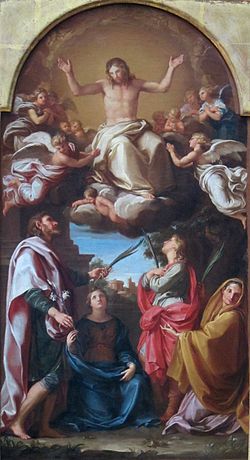Julian and Basilissa
| Saints Julian and Basilissa | |
|---|---|

|
|
| Died | ~304 AD |
| Venerated in | Roman Catholic Church Eastern Orthodox Church |
| Feast | January 9; January 6; January 7 (this last date according to calendars of the Old Hispanic liturgy, such as that in the Antiphonary of León) |
| Attributes | palm of martyrdom |
| Patronage | Basilissa is invoked against chilblains |
Saints Julian and Basilissa (died ca. 304) were husband and wife. They were Christian martyrs who died at either Antioch or, more probably, at Antinoe, in the reign of Diocletian, early in the fourth century, on 9 January, according to the Roman Martyrology, or 8 January, according to the Greek Menaea.
Their feast day is also given as 6 January, while a group of people martyred with Julian (Celsus, Marcionilla, Anthony, Anastasius) have the feast day of January 9.
There exists no historically certain data relating to these two personages, and more than once this Julian of Antinoe has been confounded with Julian of Cilicia. The confusion is easily explained by the fact that thirty-nine saints of this name are mentioned in the Roman Martyrology, eight of whom are commemorated in the one month of January. But little is known of this saint, aside from the exaggerations of his Acts.
Forced by his family to marry, he agreed with his spouse, Basilissa, that they should both preserve their virginity, and further encouraged her to found a convent for women, of which she became the superior, while he himself gathered a large number of monks and undertook their direction. The two converted their home into a hospital which could house up to 1,000 people (thus, Julian is often confused with Julian the Hospitaller).
Basilissa died a very holy death, but martyrdom was reserved for Julian under the Persecutions of Diocletian.
During the persecution of Diocletian he was arrested, tortured, and put to death at Antioch, in Syria, by the order of the governor, Martian, according to the Latins, at Antinoe, in Egypt, according to the Greeks, which seems more probable. Unfortunately, as with most saints lives the exact historical details are hard to parse from the religious tropes and maxims.
...
Wikipedia
